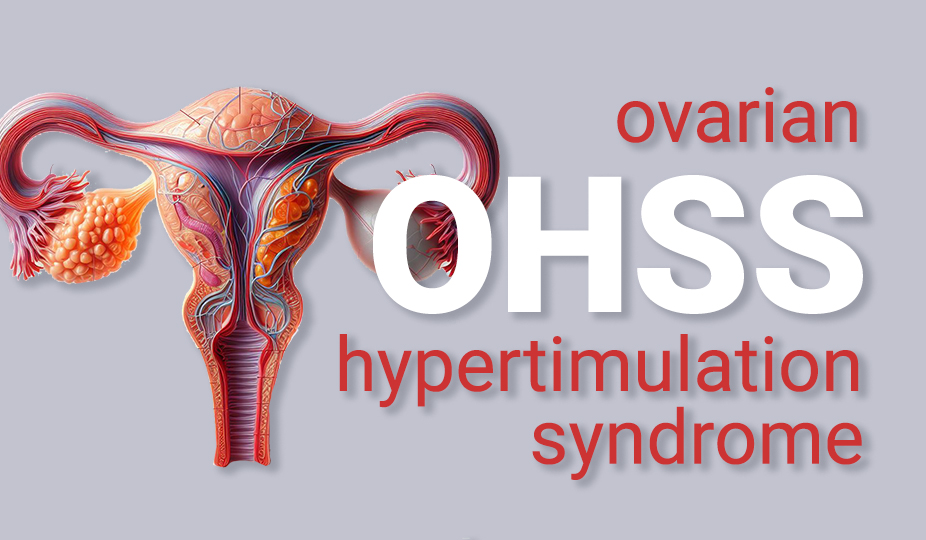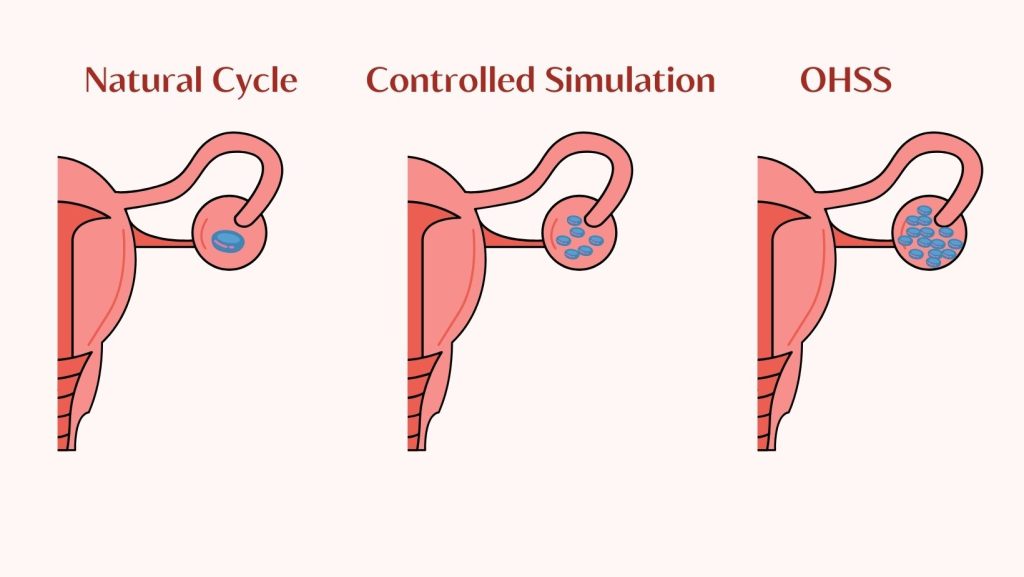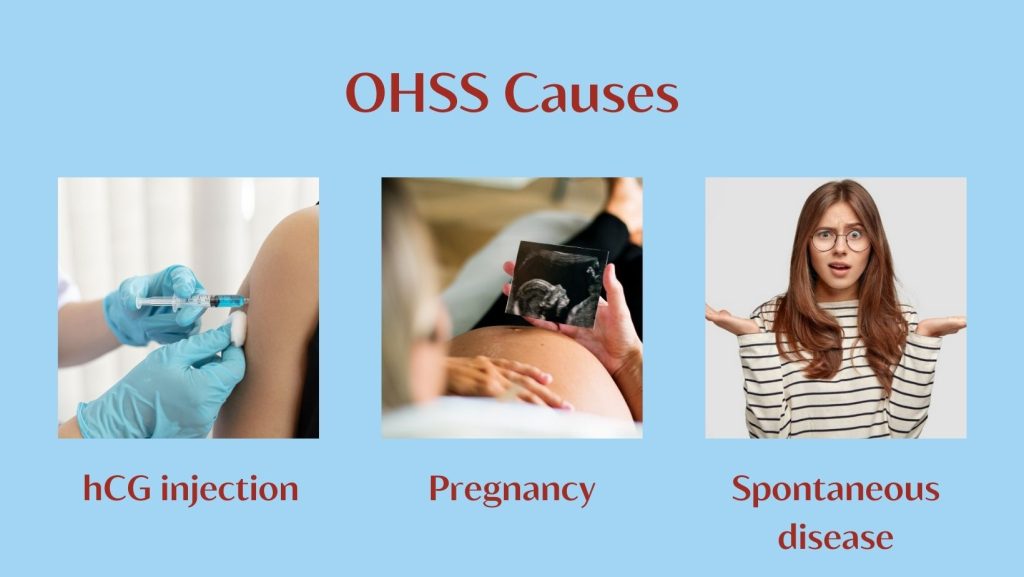Ovarian Hyperstimulation Syndrome (OHSS) – Symptoms, Causes, Prevention
Ovarian hyperstimulation syndrome (OHSS) is a woman’s body’s reaction to an excess of hormones that stimulate the development of eggs. This pathological condition occurs when the injected and natural FSH and LH hormones are too high in total. It leads to the formation of an excessive number of follicles and causes ovarian swelling and aches.

How do I identify OHSS, prevent hyperstimulation, and what are its symptoms? These questions are burning for egg donors and women preparing for IVF. Today, we will overview its symptoms, causes, and risks, and discover the frequency of the syndrome.
Ovarian Hyperstimulation Syndrome Overview
Ovarian hyperstimulation syndrome can occur during infertility treatment, IVF, and egg donation. It is characterized by swelling of the ovaries and releasing chemicals into the bloodstream. In severe cases, this fluid enters the abdominal cavity, the space around the heart, and the lungs. Why does it happen?
Naturally, a woman’s body produces one ovum per menstrual cycle. However, it may not be enough for a successful IVF and pregnancy. That is why donors undergo ovarian stimulation. It involves injections or oral pills with controlled doses of hormones to produce more mature cells.
The problem is that due to the different hormonal levels in women, it is difficult to measure the exact dose of follicle-stimulating hormones for the maturation of 10-12 eggs. So, if the sum of the infused substances and naturally produced hormones is too high, hyperstimulation occurs with the increasing number of visible follicles to more than 20. In this case, there is a risk of OHSS.
The disorder is often mild, and treatment is outpatient. However, there are more complicated cases when the patient needs hospitalization and close medical supervision. Let’s look at the course of each type.

OHSS Types
The disease’s complexity and symptoms identify the kinds of ovarian hyperstimulation syndrome. We can distinguish the following types:
- Mild – causes light discomfort due to a slight enlargement of the ovaries;
- Moderate – leads to rapid weight gain and moderate pain;
- Severe – requires immediate treatment and can become critical;
- Critical – causes fluid leakage into the bloodstream, leads to organ dysfunction, and is life-threatening.
Severe and critical forms of ovarian hyperstimulation syndrome are rare. They occur in about 1-10% of all cycles. Usually, the ailment is mild and goes away in 5-10 days.
Ovarian Hyperstimulation Syndrome Symptoms
The first signs of OHSS usually appear within a week of starting the injections. However, sometimes it takes up to 14 days to develop. Symptoms may appear gradually, worsen, or disappear over time. In the table, we list the characteristics of each type.
| OHSS Type | Symptoms | Duration |
|---|---|---|
| Mild OHSS | ovarian enlargement; abdominal discomfort; nausea; fatigue. | 3-5 days |
| ModerateOHSS | moderate abdominal pain; increased bloating; nausea and vomiting; fluid retention; shortness of breath; rapid weight gain. | 5-7 days |
| Severe OHSS | extreme bloating; nausea and vomiting; rapid weight gain; pronounced fluid retention; ovarian enlargement with cyst formation; difficulty breathing; decreased urine output; kidney distress; blood clotting abnormalities. | 7-10 days with treatment |
| Critical OHSS | distension of the abdomen; significant weight gain; respiratory distress; kidney failure; liver dysfunction; fluid retention; inability to urine output; blood blockage. | Two years or more |
Modern fertility doctors take all the necessary tests to correctly calculate the dose of hormones and avoid risks during egg donation. If you feel discomfort, contact a specialist immediately to refute the diagnosis, prescribe the necessary medications, or stop a program.
OHSS Causes and Reasons
The key cause of hyperstimulation is an increase in the level of hCG – human chorionic gonadotropin. The ovaries react painfully to this substance excess, so they swell and release fluid into the blood and abdominal cavity.

In a nutshell, the ailment occurs for some reasons:
- hCG. hCG works as a “trigger” that causes ovulation. Many donors show the first signs of OHSS within a week after this injection.
- Pregnancy. After the onset of pregnancy in the IVF cycle, the body begins to produce its own HCG. If there is a surplus of the hormone, hyperstimulation ailment may occur.
- Spontaneous disease. Sometimes, the pathology is not related to IVF or donation and happens due to an imbalance of hormones in the body.
Who is at Risk of OHSS?
Although hyperstimulation may start without preconditions, there is a group that is more likely to experience this disease. The following factors increase the likelihood of OHSS:
- age under 35;
- low body mass index;
- polycystic ovary syndrome (PCOS);
- the naturally high number of follicles;
- elevated levels of the Anti-Müllerian hormone;
- OHSS in the past;
- high concentration of estradiol in the blood.
It is worth noting that the presence of a particular characteristic is not a guarantee of complications during egg donation. Consult with a fertility specialist to learn more about your case and to choose the most gentle program.
How Common is Hyperstimulation in IVF?
Mild OHSS is quite common among women undergoing IVF: approximately 33 out of 100 women, or 33%, experience it. At the same time, only 1% of patients have severe OHSS.
Below, you can view the case statistics of 289 oocyte donors.
| OHSS Category | Percentage of Oocyte Donors |
|---|---|
| No OHSS | 13% |
| Mild OHSS | 35% |
| Moderate OHSS | 39% |
| Severe OHSS | 12% |
| Critical OHSS | 1.38% |
OHSS Complications
In critical cases, when the ovarian fluid release is too strong, it can be a threat not only to pregnancy but also to life and health. Possible complications include:
- fluid accumulation in the abdominal cavity;
- thrombosis;
- renal failure;
- cyst formation and rupture;
- bleeding;
- miscarriage or abortion;
- death (uncommon).
Ovarian Hyperstimulation Syndrome Diagnosis
Doctors diagnose hyperstimulation based on the patient’s symptoms and complaints. The following tests are taken to confirm the disease:
- Bloodwork. Elevated hormone levels indicate the development of hyperstimulation.
- Ultrasound. An ultrasound examination allows doctors to identify an excessive number of follicles and an increased size of the ovaries, which indicates a possible pathology. At a more advanced stage, it reveals free fluid in the abdominal cavity.
- Chest X-ray. It shows fluid in the lungs.
- Medical examination. Waist measurement helps to detect edema. A pelvic examination is forbidden as there is a risk of ovarian rupture due to high pressure.
In modern clinics, treatment goes under the close supervision of reproductive specialists, and patients undergo ultrasound every 2-3 days of the cycle. That is why suspected hyperstimulation is detected at the early stage. It helps prevent complicated cases and brings the cycle to a successful egg donation or pregnancy.
OHSS Treatment Guidelines
Treatment depends on the disease course and the complexity of the individual case. In the mild form, it is outpatient and does not require medication. So, if you have been diagnosed with mild hyperstimulation, we recommend following these tips:
- bed rest;
- abundant fluid intake;
- daily weighing;
- healthy diet.
Severe and critical courses require immediate hospitalization to prevent complex consequences. Usually, specialists take the following measures for treatment:
- intravenous injections of fluids to thin the blood;
- medications to reduce blood clots;
- paracentesis – removal of fluid from the abdomen;
- antibiotics to prevent infection;
- medicines containing proteins;
- drugs to reduce ovarian activity;
- thoracentesis – removal of fluid from the chest cavity by a puncture.
How to Prevent Hyperstimulation Syndrome?
All examinations before and during IVF aim at identifying the likelihood and preventing diseases. It includes a set of tests to measure follicle size and a highly detailed study of the patient’s medical history. Based on these data, the fertility doctor draws up an individualized plan with the most optimal dosage of medications. It is the first and critical step in preventing the disease.
In addition, the following strategies bring desired results:
- Drugs. Some drugs in small doses, such as aspirin or cabergoline, can reduce the risk of OHSS without harming a future pregnancy.
- hCG injection. As already mentioned, hyperstimulation ailment sometimes arises after the hCG injection. Therefore, doctors use alternatives that also trigger ovulation. Among the popular drugs is Leuprorelin.
- Coasting. If the blood test shows an increased level of estrogen or too many follicles are visualized on the screening, then the program may be stopped. The pause lasts for several days until the hormonal background decreases. After that, hCG is infused to cause ovulation and continue the program.
- Embryo freezing. If there are signs of hyperstimulation, a healthcare specialist may retrieve gametes for fertilization and freeze the embryos. This way, the body will have time to recover before pregnancy. You may continue the IVF cycle after the recovery and the normalization of the ovaries.
Erin’s Egg Retrieval with OHSS
Erin overcame a long journey of struggling with infertility and finally became pregnant. She talks about all of her IVF challenges, including OHSS, on her YouTube channel.
I had egg retrieval and was warned about possible cramping and bloating due to ovarian hyperstimulation syndrome. The first hours after the anesthesia and at home, I felt awful. However, in a day, the symptoms went away. We got 14 eggs and 10 embryos!
Watch this video to see the whole of Erin’s story and experience.
Kelsie’s Moderate OHSS Story
Kelsie and her husband Anthony struggled with infertility for 5+ years until they had a beautiful baby boy in 2022. Throughout their IVF journey, Kelsie experienced miscarriages, polyp removal, PCOS, and OHSS. She shares her case of hyperstimulation in the video below.
I had moderate OHSS and ovarian enlargement due to excess hormones. We canceled the embryo transfer and had to freeze embryos to continue the program after recovery.
You can watch the whole story here.
OHSS Experience with A Severe Case
Severe hyperstimulation has excruciating symptoms and complications if the disease is left to chance. However, with timely diagnosis and well-selected medications, you have all prospects for recovery and further pregnancy. Sara Maria’s story proves it!
Today, I will share my story of egg retrieval and my experience of developing a severe case of OHSS. I have PCOS, so I am at risk for hyperstimulation. I started my course with nightly abdominal injections, after which my estrogen levels became ridiculously high. My ovaries grew so large that they touched each other and were the size of a grapefruit. I couldn’t lie down, so I had to sleep sitting up. The pain was very severe.
Despite all the difficulties, Sara Maria completed treatment and now has a long-awaited baby.
Ovarian Hyperstimulation Syndrome FAQ
Hyperstimulation does not cause death by itself. However, the complications associated with it, including thrombosis or renal failure, may be life-threatening. In such cases, the mortality rate is approximately one person per 50,000 people.
The estradiol level and the number of follicles are predetermining factors for the development of hyperstimulation. If more than 20 follicles are visualized in the ovary and the estradiol level exceeds 4000 pg/ml, the likelihood of pathology is moderate. If the patient has more than 30 follicles and 6000 pg/mL of estradiol, there is an 80% probability of hyperstimulation. Thus, the dangerous line of the hormone level is the value of 4000-6000 pg/ml.
Hyperstimulation reduces the chances of fertilization, but the quality of the resulting cells and embryos remains the same.
Final Words
Ovarian hyperstimulation syndrome is quite common among egg donors and women undergoing IVF. Most often, it is mild and does not have severe health consequences.
Sunshine Agency takes all the necessary measures to avoid the ailment or detect the problem at an early stage. The egg donor’s health is our priority, so we never promote dangerously high doses of medicines within the programs. Careful selection of medications and dosages, regular monitoring, and immediate medical care help minimize risks and provide a successful IVF journey. If you want to donate eggs or have questions about IVF programs, contact our specialists for a detailed consultation.